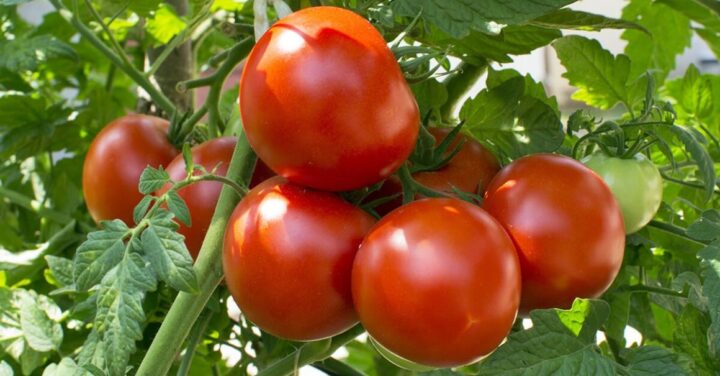
Tips for growing tomatoes: Large, round and juicy
Tomatoes are a common vegetable. And if you look around in summer, they grow in almost every vegetable patch. So it can be pretty frustrating when you don’t harvest it yourself.
Tomatoes are very demanding when growing them. The wrong location, too little or too much water and unsuitable fertilizer can lead to crop failure or the plant dying. Because the tomato is actually sensitive and its cultivation prone to errors. Experts name the most important tips.
How much space does a tomato plant need?
You can prevent diseases by spacing the plants. 2.5 plants per square meter are optimal, advises Katrin Quinckhardt from the North Rhine-Westphalia Chamber of Agriculture. Plants are either tied to a stake at least 1.5 meters long, or they are guided up to a transverse wire about 1.5 meters high by twisting the shoots clockwise around a string.
Mixed crops: what can you plant next to tomatoes?
With tomatoes, it is important that they have the right bed neighbor. Because these ensure that insects are attracted that pollinate the flowers of the tomato plant. And this is important for a bountiful harvest. However, if you put the wrong plants in the vegetable bed, this can damage the tomato: some plants remove the nutrients that are important for the vegetables from the soil. Pests are also increasingly attracted to certain neighboring beds. Next to tomatoes you should not put:
Peas
fennel
cucumbers
potatoes
Beetroot
Red cabbage
It is best to place the following plants next to the tomato:
basil
bush beans
Lamb’s lettuce
garlic
cabbage
Parsely
radish
chives
zucchini
What nutrients do tomatoes need?
The tomato needs a lot of nutrients for the fruit to taste good. “If the plants are over-fertilized, this can lead to blossom end rot, for example,” explains Quinckhardt. The good mediocrity looks like this: When planting, you should work three kilograms of half-ripe compost or rotted manure per square meter into the top layer of soil. In addition, there are about 80 grams of horn semolina per square meter or 140 grams of castor meal per square meter. It may also be important to add calcium using a special fertilizer.
Do tomatoes need special protection?
Tomatoes are susceptible to fungal diseases. If it rains particularly heavily and the temperature is between 13 and 18 degrees, late blight spreads more, explains Mareile Zunker from the Augustenberg Agricultural Technology Center in Karlsruhe. “She can destroy the entire crop.”
The solution: The leaves must not get wet (anymore). “Many gardeners build small roofs over the tomato plants so that they don’t stand directly in the rain,” says Zunker. Watering is also done in the morning or afternoon so that the plants dry off again by the evening. “And always water from below so the leaves don’t get wet.”
If the plants also have too many leaves – i.e. if they are too close together so that they do not dry well – you should remove the lowest ones up to the fruit stand that has just been harvested.
How often are tomatoes watered?
Excessive drought is just as dangerous as too much moisture. “Tomatoes need a lot of water,” says Marianne Scheu-Helgert from the Bavarian Garden Academy. “For a chest-high plant, count on two to three liters a day, more on hot summer days.” However, she advises not to give the entire amount of water at once, but spread it out over two to three hours. “The soil can only absorb a certain amount of liquid, the rest just drains away.” By the way: A layer of straw or grass clippings on the floor makes it more receptive to water.
Don’t exhaust every tomato plant
Ausgeizen is a buzzword in tomato care: It is the removal of regrowing side shoots. In this way, the plant can put all its energy into the main shoot. But there are exceptions: “For beginners, determinate plants are well suited because they don’t have to be exhausted,” advises Scheu-Helgert. These are bush tomatoes, the top shoots of which, like the side shoots, always end in a flower.
When do I have to harvest my tomatoes?
There is no exact date when you should harvest tomatoes. Depending on the weather conditions, the fruit may be ripe earlier or later. It is therefore important to both look at and touch the tomatoes in order to find out the right time to harvest.
The tomatoes should be completely colored.
The flesh is hard, but gives way a little.
The fruits can be easily removed from the fruit stalk.
You should not harvest and eat green tomatoes. They can be poisonous.
Tomatoes will wrinkle on the plant
If unripe fruits collapse while still on the plant, this can have various reasons. The most common is a lack of water. Both the plant and the tomato need sufficient water to thrive. If the tomato plant is letting its leaves droop and is no longer able to stand sufficiently, you should change your watering rhythm.
Another possibility can be pests that eat the roots of the plant – so-called nematodes. If the plant changes color or grows rather poorly, you should check whether the roots are affected. In this case, you should remove the affected plant and the soil from the bed to contain the pest infestation.
Categories: General
